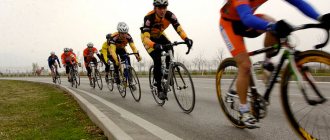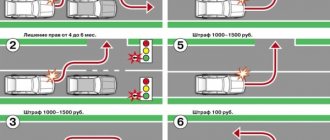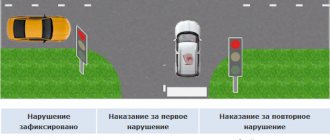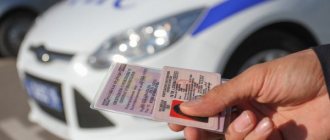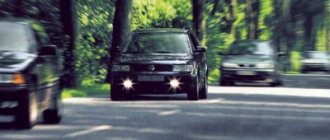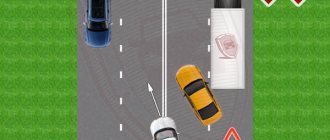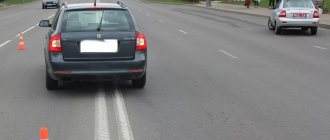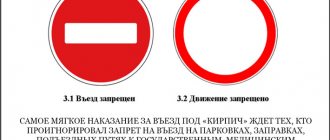Road accident concept
Surely every driver has an idea of what a traffic accident is and what its consequences may be. However, not every accident can be classified as a traffic accident, so we need an accurate definition. It can be found in clause 1.2 of the Traffic Regulations, Art. 2 Federal Law N 196-FZ, which is responsible for road safety, the Code of Administrative Offenses and the law on compulsory motor liability insurance.
An accident is an event involving a vehicle that occurs while driving on the road, resulting in injuries or deaths, damage to the vehicle and the cargo or structures it carries, or any other material damage.
Moreover, these “events” have their own classification, risk factors and different consequences. An accident must be recorded and documented according to the generally accepted procedure for road users and the traffic police.
How to determine who is at fault in an accident at an intersection
Disassembly after an accident is a fairly common occurrence. Everyone wants to prove that they are right in choosing the order of travel. Practice shows that it is especially difficult to identify who is to blame for an accident when turning left. True, there are often other options. But the State Traffic Inspectorate solves such problems, even if there are no video cameras. The one who violates the rules, which are described in detail in Art. 13 traffic rules.
When approaching an intersection, you need to take into account priority signs, rowing, markings and the presence of tram tracks. In addition, the following are considered general rules for competently negotiating an intersection:
- When turning (no matter in which direction), it is necessary to provide passage for pedestrians and passage for cyclists crossing the road.
- It is prohibited to enter an intersection with a congestion, which will certainly lead to a stop that will impede cross-vehicle flow.
On unregulated
At many of our intersections there is neither a traffic controller nor a traffic light. Often the latter does not work. In the rules, such road crossings are called unregulated. The culprit in an accident at this type of unequal intersection is determined by violation of priority signs.
The person at fault is considered to be driving on a secondary road and not allowing a vehicle to pass on the main road. The latter is not called that for nothing; it determines priority. If the main road changes direction, drivers are required to pass each other according to the rules for driving through equivalent intersections: if you see an obstacle on the right, stop, let them pass and drive calmly. The same principle works on secondary roads, even for trams.
When entering a circle, you must give way to all vehicles moving along it. When making a left turn/U-turn on an equivalent road, you should give way to all oncoming cars heading straight or to the right. This rule also applies to carriage drivers.
On adjustable
An intersection, the order of passage of which is determined by a traffic controller or a traffic light, is called a controlled intersection. When turning left/turning back at the permission signal, you also need to give way to oncoming vehicles moving straight or to the right. When moving along the arrow along with a yellow or red signal, you must let vehicles from other directions pass.
If a traffic light/regulator allows the movement of a tram and a car, then the former has priority. But on a switch with a red or yellow signal, the tram is also obliged to let vehicles from other directions pass.
The driver entering the intersection must complete the maneuver regardless of the signal. If, when turning in front of traffic lights, there are stop lines in the markings, you must obey the requirements of each of them. Even with a permitting signal, you are required to give way to vehicles and pedestrians who did not manage to complete their movement in a timely manner.
On unequal
On a secondary road, the driver must first always let those following on the main road pass, regardless of the direction of their movement. It's simple: I stopped, let it pass, then drove off myself.
You can tell which road is the main one by looking at the road signs and the quality of the surface. If there are no signs, and the quality of the surface cannot be visually determined (bad weather, visibility, etc.), you must assume that the road is of secondary importance.
On equivalent
At an unregulated equivalent intersection, the right-hand rule is used. The tram here enjoys an absolute advantage over other vehicles, regardless of the direction of travel.
Accident with a car on the main road
First of all, let's look at a typical accident at an intersection:
An orange car leaves a secondary road and collides with a white car. The reasons in this case can be different: driver inattention, limited visibility (parked cars, buildings, bushes or trees), incorrect assessment of the road situation.
Paragraph 13.9 of the traffic rules:
13.9. At the intersection of unequal roads, the driver of a vehicle moving on a secondary road must give way to vehicles approaching on the main road, regardless of the direction of their further movement.
Those. The culprit of this collision is the driver of the orange car and it is he who will pay for the repair of the white car.
Uncontrolled intersection: collision when turning left and overtaking
Driving through an uncontrolled intersection is more difficult, because no one gives instructions in what order to drive. Therefore, in case of accidents in such places, it is more often possible to find the fault of each participant in the accident.
In addition to observing the order (priority of passage), it is necessary to take into account the possibility of overtaking a vehicle coming from behind. Overtaking is definitely prohibited at controlled intersections, but not always at unregulated intersections. In clause 11.4 of the traffic rules it is noted that overtaking is not allowed only on a secondary road and pedestrian crossings.
The fault of the driver making the turn
Any change in the direction of movement of the vehicle must be indicated by turn signals (Section 8.1 of the Traffic Regulations). If there are several lanes, the driver who sees another car on the right turning left must let it pass.
Before turning left, the driver must assess the situation and make sure that other cars behind and to the left will not interfere with him. If these conditions are not met, he will be found guilty in an accident.
The overtaking driver's fault
Even passing from the left lane often causes collisions with cars turning left at uncontrolled intersections, although overtaking is not prohibited here. Article 11.2 of the traffic rules states that overtaking is prohibited when the car in front has already turned left. If this is not noticed in time, the State Traffic Inspectorate will decide the issue not in favor of the “racer”. But traffic rules also prohibit preventing overtaking by increasing speed and so on. If the turning driver is caught doing something like this, he will be found guilty.
Controlled intersection: accident when turning left and overtaking
Even at a controlled intersection, you can get an unexpected side impact when turning left.
Driver's fault when overtaking
Overtaking at a signalized intersection is prohibited. Therefore, the driver of the overtaking car is found guilty.
Driver's fault when turning left
If the traffic light/traffic signal allowed the maneuver, the left turn signal was on, there were no obstacles on the left, the culprit is the driver who turned into the wrong lane (multi-lane road) or tried to overtake. If some rules were not followed by each participant in the accident, you will have to figure out who is more to blame. Logically, this is the first person to commit wrong actions and violate traffic rules.
Who is to blame for an accident when turning left?
Determining who is at fault for an accident depends on the characteristics of the incident. Let's say a driver turns left from the right lane at an intersection. The situation is quite typical. It is presented in the diagram below.
Considering the above situation, many drivers talk about the presence of an obstacle on the right. If you follow this rule, the blue car must give way to the red one. However, in reality the situation is regulated by clauses 8.5 and 8.7 of the Russian Traffic Regulations. From the provisions of the legal act it follows that in the presented situation the red car is to blame. The driver will be punished for not taking the extreme position before the turn, which resulted in an accident when turning left.
In practice, there may be no stripes. In this situation, you will need to take the extreme left position. If there is two-way traffic, but there are no markings, you need to visually divide the road in half. To turn left, you need to position the car so that if another driver wants to be to the left, he will be in the opposite direction.
Signs should be taken into account. Consider the situation presented in the diagram below.
The Russian Traffic Regulations do not say that signs of special instructions cancel the effect of paragraph 8.5 (Before turning left, the driver must take the appropriate extreme position in advance). At the same time, both cars made a turn in the permitted trajectory. Here it is worth turning to judicial practice. It all depends on how the judge looks at the situation. It may be decided that compliance with clause 8.5 of the Russian Traffic Regulations is of paramount importance. In this case, the driver of the red car will be punished. If the representative of the authorized body considers that both drivers are not violating anything, clause 8.9 of the Traffic Regulations of the Russian Federation comes into force. In this case, the driver of the blue car is obliged to let the red car pass, since there is an obstacle on the right.
All vehicles may only turn left.
The presence of signs does not mean that it is not necessary to comply with clause 8.5 of the Russian Traffic Regulations. In this case, the driver of the red car is found guilty.
A person turning from the far left may try to immediately get into the right lane. In this case, the risk of an accident, shown in the diagram below, increases.
There is an opinion that when turning, drivers are required to move to a similar lane. However, there is no such requirement in the traffic rules. A driver turning from the far left position may immediately move into the far right lane. Analyzing the accident reflected in the above diagram, the inspector will determine that the driver of the red car violated paragraph 8.5 of the Russian Federation Traffic Regulations.
However, if markings are applied indicating the trajectory of movement, the driver of the blue car is found guilty.
When making a left turn, a citizen may refuse to let an oncoming car pass. As a result, an accident will occur.
Determination of guilt in an accident when turning left is carried out taking into account the traffic light signal, if present. Additionally, priority signs are taken into account. They regulate the order of passage of vehicles. If the intersection is controlled and the light is green for both drivers, the blue car is found guilty of the incident. He violated paragraph 13.4 of the traffic rules. If the light is red, both drivers are violating.
When the intersection is unregulated and there is a red car on the main road, the blue vehicle remains at fault. If blue is on the main board, the fault will be seen in the actions of red.
The oncoming driver can turn right. An accident will occur if one of the cars tries to get into someone else's lane.
If the driver of a blue car wants to change lanes to the second row, the person is obliged to give way to a red vehicle (clause 13.4 of the Russian Traffic Regulations). However, the exact opposite situation is possible. If Red wants to occupy the left lane, and Red also tries to get into it, the interpretation is rather ambiguous. The fact is that clause 8.6 of the Russian Traffic Regulations states that a driver turning right should move as far to the right as possible only if possible. This means that if a person driving a red car had such an opportunity, but did not take advantage of it, the person will be found guilty of an accident. In the diagram, the red car is not required to give way.
Turn left: controversial situations
As is already clear, road accidents when overtaking and turning left at intersections are caused by a series of mistakes and violations of the rules committed by all its participants. This is where controversial issues arise. A simple example: a car intends to turn left on a yellow signal and has even started the maneuver, but the driver of the oncoming car ignored this and drove into his right side. Who will be guilty?
On the one hand, the first driver, because he did not let oncoming traffic pass. But on the other hand, he started his maneuver earlier, and the oncoming car could have started moving on a yellow rather than a green signal. This is where you have to prove your case to every driver. Almost everything is taken into account:
- traffic light markings and operation;
- the distance from the oncoming car to the intersection at the moment of starting movement;
- speed of both cars;
- the ability to apply emergency braking;
- whether the turn signal was turned on.
Testimony of witnesses (eyewitnesses), recordings of video recorders and surveillance cameras will help the traffic police inspector to correctly assess the situation. If the protocol does not satisfy one of the drivers, a department commission or even a court will decide who is guilty in a particular situation.
At a T-junction, when turning left from a secondary road onto the main road, a situation may also arise where both drivers are at fault. Suppose the first one arrived, stopped, turned on the turn signal, looked around and began to turn, but at that moment a car moving on the right crashes into him. The first one is guilty because he did not make sure that there was no obstacle or did not estimate the speed. The second one was driving too fast and either did not see or did not have time to brake. It is very difficult to determine who is right and who is wrong.
When leaving the side of the road, we actually make a left turn. And this is where disputes often arise. The driver leaving is obliged to turn on the turn signal and make sure there are no obstacles, and the driver moving along the road is obliged to let it pass or take all measures to prevent a collision.
Accident when turning left at an intersection when one of the cars is already at the intersection
An accident occurs if a person about to turn reaches the middle of the intersection and only then begins to prepare for the maneuver, notifying other road users. The citizen lets other cars pass and then makes a turn. However, a car moving in the opposite lane cannot always be noticed; there are times when a car jumps into an intersection unexpectedly. As a result, cars collide. Guilt is determined depending on the presence of priority signs, markings, and traffic lights.
For your information
A driver making a left turn must inform other road users in advance about the upcoming maneuver. A car owner driving straight needs to more carefully assess the situation on the road. It is possible to assign mutual fault in an accident. To clarify your specific situation, consult a free online lawyer in the chat at the bottom of the screen or by phone.
What to do after an accident
A detailed algorithm for the driver’s actions immediately after an accident is indicated in the traffic rules in the responsibilities section. It is clear that you cannot leave. You need to stop, turn on the emergency lights, set the triangle, and then assess the situation. If there are victims, provide first aid or take them to hospital. Then you need to call the traffic police, record the location of the cars and clear the roadway if possible.
Then you can look for eyewitnesses and inform the insurance company. Read about whether a certificate and notification of an accident are required.
